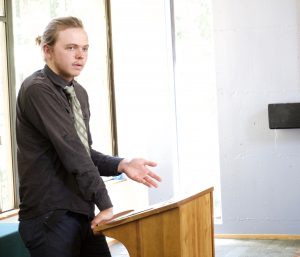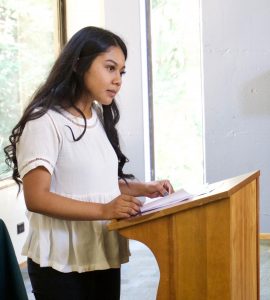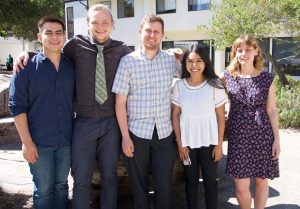This Friday, May 18th, at 1:30 pm in Humanities 1, Room 210, there will be a colloquium by Meghan Sumner (Stanford). Her talk is entitled “Usage-based linguistic models and understanding human behavior.” Afterward, there will be a reception at 3:30pm in the Silverman Conference Room. The abstract is given below:
The past three decades of research in phonetics and psycholinguistics have led to great advances in our understanding of language, representation, and the relationship between language and other cognitive domains. While debates certainly still exist, we can take as established that how often and in what context different speech patterns occur influence both memory and processing. The question now is what we do with this rich foundation.
In this talk, I present a few, short examples of how usage-based approaches to phonetics and psycholinguistics help us understand social biases and human behavior. I provide some evidence showing that phonetically-cued talker information (e.g., emotion, gender) directly activates lexical items, providing us with some insights into the timing and availability of this information. The purpose of this first part is to illuminate the complexity of experiencing linguistic events from the perspective of a listener.
For the remainder of the talk, I move away from phonetics, taking the basic insights from the studies initially presented (e.g., that we are pattern recognizers) to question assumptions about language use and experience and ask how our understanding of language use, semantic associations and culture can inform society at large. Specifically, I spend the last large chunk of this talk investigating how we can understand the refugee experience through the lens of spoken language comprehension.
Some background: As developed democracies settle an increasing number of refugees, refugees have been displaced, face daunting new laws and cultures, and yearn to make a new land their home. Regardless of perspective, that of the government or that of the refugee, numerous challenges litter the path to refugee integration. The goal of host countries is integration – realized as an ideal, productive member of society, where society stays the same and refugees learn to talk and act a certain way. In this view, language is an important measure of integration. But I argue, it is a misleading one.
As humans, we understand the world around us through sight, touch, smell, and the sounds of language. We are pattern recognizers, and we make meaning from co-present cues. For example, the cartoon Tom and Jerry does not use language at all, but from it we learn to associate the animal that meows (‘cat’) with the animal that squeaks (‘mouse’). Associations like these are culture-specific; and experience leads to re-weightings that result in a new understanding of the world, and influence the way one uses language. Focusing on Syrian and Afghan refugees in Hamburg, Germany, I propose to examine whether Arabic-speaking Syrian refugees and Dari- and/or Pashto-speaking Afghan refugees living in Hamburg for two years have re-weighted their language associations to be culturally German, compared to refugees living in Hamburg for less than 6 months. This research would show that part of the integration process, at least, is facilitated through the native language of the refugees, not hindered by it.
Three distinct but related hypotheses are investigated: (1) refugees have adapted to German culture via their native language, (2) engagement with mentors who have lived in Germany facilitates this process, and (3) this occurs regardless of literacy (more than half of Afghan refugees in Germany are non-literate). At times, we have a vision of the “ideal”; convinced that integration means “like us”. Sometimes, this ideal involves pushing back against differences such as language, that is often the one thing displaced refugees hold onto as a memory of their past lives. This talk questions that ideal, and suggests that models that harness the power of language and community may alter our ideas about integration and improve the refugee experience.





